|
Ladakh Wildlife |
|
|
|
Ladakh, also known as
the 'land of passes', was discovered by Fa-hian, who
traveled across its inhospitable terrain in 399 AD. He
described Ladakh as the land where snow never melts and
only corn ripens. The mysterious Ladakh stands at a
height 4,600 meters in the outer Himalayas with its
peaks, ranging |
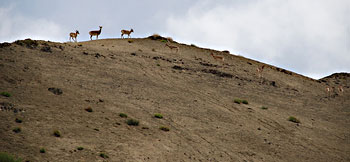 |
|
|
from 5,800 to 7,600 meters
forming the most striking feature of the area. The Himalayas
are very higher than the other mightiest mountains anywhere in
the world. For endless years, before man had even discovered
this remote land, several animals and birds lived together
here in an exquisite equilibrium. Today, Ladakh's flora and
fauna are threatened and protection is vital if the ancient
ecosystem has to survive the trauma of modern man. The area of
Ladakh is unique and its climate supports some rare species of
animals and birds. Due to its geographical location, the
Ladakh's ecosystem is one of most fragile and at the same time
most fascinating in the world. The landscape of Ladakh is
characterized by uneven terrain, forbidden valleys, rugged
landscape, and snow-swathed mountains which rise to several
thousand feet above one of the most elevated plateaus on the
earth. Ladakh is a mountainous, Arctic cold desert with no
signs of trees far and wide. Winds blow here at a very high
speed and everything is parched by |
|
|
|
the dryness of the
atmosphere. A few narrow fertile valleys are scattered
here and there, and provide a clear sparkling air. With
its barren plateaus it makes feel one surprising to know
that Ladakh is so rich in flora and fauna. Ladakh
possesses virtually no natural forests, although along
riverbanks and valleys some greenery does exist. The
lower mountain slopes are sparse but higher up, near the
snow line, wild rose, willow and herbaceous plants are
there. While soil, wind, precipitation and exposure
determines the presence of specific life, |
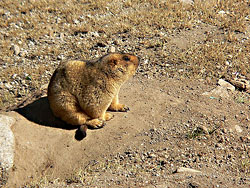 |
|
|
the temperature also changes
at different altitudes. Because of the decrease in the
temperature, vegetation becomes more sparse and stunted in the
higher slopes. In this extremely harsh environment, animals,
which have adapted to the rigorous conditions however, thrive
on the minimal vegetation, poor shelter, rocky terrain and
bitter cold. Most of the creatures migrate to lower regions in
winter while others, like the brown bear and marmots
hibernate. Ironically, at this altitude many animals suffer
from "mountain sickness" because of the lack of oxygen! Most
of the large mammals have a unique device for protection
against the cold - a highly insulated shaggy coat. They,
therefore, have less need for shelter from the elements. Due
to this, more species of goat and sheep live here in open
country than anywhere else on earth. During your sightseeing
or trekking in Ladakh you would have a local Guide at your
disposal and he would be glad to tell you more about the
wildlife in Ladakh. |
|
|
|
Birds
The Bactrian magpies, Turkoman rock pigeon, desert
wheaters, buntings, larks, kite, kestrel and many kinds
of finches, ducks, geese and hundreds of species of rare
Himalayan birds inhabits the region of Ladakh. Many
migratory birds can be seen in Ladakh during the summer
month. The most famous of them is the Black-necked
Crane, which can be seen in V-shaped formation across
the clear Himalayan sky. |
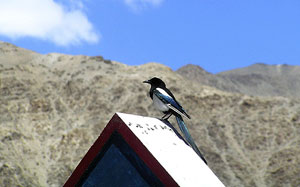 |
|
|
|
|
Bharal
Bharal, a blue sheep can be seen at the height of 6000 feet.
In summers they graze on the rich and abundant grasses of the
alpine meadows. Their brownish-gray color provides them with
protective camouflage and as they often stand motionless they
can be extremely difficult to spot but, when alarmed, Bharal
will bolt swiftly to safety. As this species of sheep posses
the appearance of both sheep and goat, so they play a vital
role in the mythological stories related to Buddhism.
|
|
|
|
Snow Leopard
The greatest attraction of Ladakh is the Snow Leopard.
The Snow leopard is one of the rarest wild animal. The
Snow Leopard faces extreme threat from the poachers as
their skin being popular in Tibet is smuggled and sold
in the local market. The Snow Leopard is one of the
endangered species and is officially a protected animal.
|
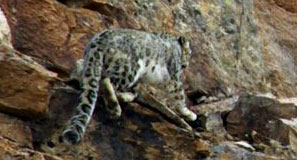 |
|
|
|
|
Nyan
Nyan, the great Tibetan Sheep is another attraction of Ladakh.
Nyan is the largest and most magnificent wild sheep. About 200
Nyans are found in the extreme eastern portion of Ladakh. The
nyan normally remains at a great height and rarely descends to
a level below 4,500 meters. Male Nyans are very attractive as
they have long and huge curving horns which measures as long
as up to 140 cms. The fighting between two Nyan makes it a
good photo motive. |
|
|
|
Urial
Small sheep, also known as Urial or Shapu can be seen
at a height of 3000 to 4000 meter in the grassy mountain
slopes. Urial also play an important role in the local
food chain of the hunting animals. The urial weighs 85
Kg. and has horns measuring upto 99 cm. Urial is the
smallest sheep in eastern Asia. The meeting of these
species takes place during December-January and they
give birth to their young ones around May. The need for
protection of the Urial is great as they are within the
easy reach of |
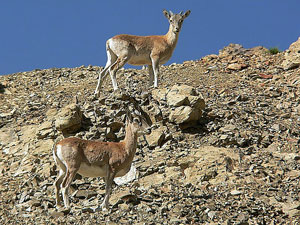 |
|
|
hunters. Their numbers have
been declining rapidly and it is estimated that there are not
more than 500 sheeps in Ladakh. According to the survey by the
Wildlife Department of Jammu & Kashmir there are only 34 to 50
sheeps in the Markha and Rumbak valleys. |
|
|
|
Yaks
Yak (dong), a wild ox is the largest animal of the cold
desert. Yak was first described only a century ago by
the famous Russian naturalist and explorer, N. M.
Przewalski as most imposing than its placid domestic
counterpart. Yak is immensely shaggy and weighs about a
ton. It has curved horns whose tips can be as wide apart
as 90 cm. and measure 76 cm. over the curves. It can
easily be distinguished by its long black hair, which is
tinged with gray at the |
 |
|
|
muzzle. The yaks graze on
the Himalayan valley at the height of over 6,000 meters in
summer. In the winters, yaks migrate to lakes, marshes and
lower valleys. |
|
|
|
Chiru
A rare Tibetan gazelle or the Tibetan antelope “Chiru” can be
seen in small groups. “Chiru” falls under the protected
species. This antelope is prized for its fleece which produces
Shahtoosh, the very fine best wool used to make shawls. Now
the trading of the wool has been banned in order to ensure the
survival of these wonderful antelopes. |